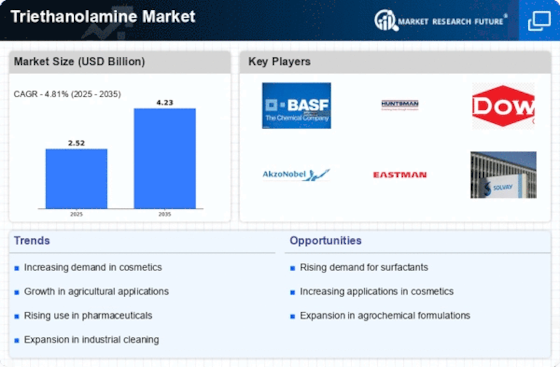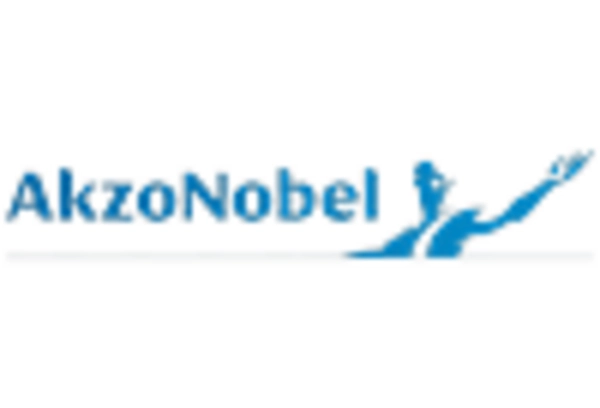Growth in Agricultural Applications
The Triethanolamine Market Market is witnessing a significant expansion in agricultural applications, particularly as a surfactant in pesticide formulations. Its ability to enhance the effectiveness of active ingredients in herbicides and fungicides is driving its adoption among agricultural producers. In recent years, the agricultural sector has increasingly recognized the benefits of using triethanolamine, leading to an estimated growth rate of 5% in this segment. This trend is expected to continue as farmers seek more efficient and effective solutions for crop protection. The integration of triethanolamine in agricultural products not only improves efficacy but also aligns with the industry's shift towards sustainable practices, thereby reinforcing its position within the Triethanolamine Market Market.
Rising Demand in Personal Care Products
The Triethanolamine Market Market is experiencing a notable surge in demand due to its extensive use in personal care products. This compound serves as an emulsifier and pH balancer, making it a preferred ingredient in cosmetics and skincare formulations. The increasing consumer awareness regarding personal grooming and skincare is propelling the growth of this market segment. In 2023, the personal care sector accounted for approximately 30% of the total demand for triethanolamine, indicating a robust trend towards its incorporation in various formulations. As consumers seek products that enhance their beauty and well-being, the Triethanolamine Market Market is likely to benefit from this growing inclination towards personal care, suggesting a sustained upward trajectory in demand.
Emerging Markets and Economic Development
The Triethanolamine Market Market is poised for growth as emerging markets experience rapid economic development and urbanization. Countries in Asia and Latin America are witnessing increased industrial activities, leading to a higher demand for triethanolamine in various sectors, including construction, agriculture, and personal care. The rise in disposable income among consumers in these regions is also contributing to the demand for personal care products, further driving the market. In 2023, emerging markets accounted for approximately 25% of the total triethanolamine consumption, indicating a robust potential for future growth. As these economies continue to develop, the Triethanolamine Market Market is likely to expand, presenting opportunities for manufacturers to tap into new customer bases.
Increasing Use in Industrial Applications
The Triethanolamine Market Market is significantly influenced by its growing utilization in various industrial applications, including textiles, paints, and coatings. As a versatile chemical, triethanolamine acts as a surfactant and stabilizer, enhancing product performance across these sectors. The textile industry, in particular, has seen a rise in the use of triethanolamine for its ability to improve dyeing processes and fabric treatments. In 2023, industrial applications accounted for nearly 40% of the total triethanolamine consumption, reflecting a strong demand driven by the need for high-performance materials. This trend suggests that the Triethanolamine Market Market will continue to thrive as industries increasingly prioritize quality and efficiency in their production processes.
Regulatory Support for Chemical Innovations
The Triethanolamine Market Market is benefiting from favorable regulatory frameworks that encourage innovation and the safe use of chemicals. Governments are increasingly recognizing the importance of triethanolamine in various applications, leading to supportive policies that facilitate research and development. This regulatory backing is crucial for manufacturers looking to explore new formulations and applications, particularly in the personal care and agricultural sectors. As regulations evolve to promote sustainable practices, the Triethanolamine Market Market is likely to see an influx of innovative products that meet consumer demands while adhering to safety standards. This environment of regulatory support may enhance the competitive landscape, fostering growth and expansion opportunities.

















Leave a Comment